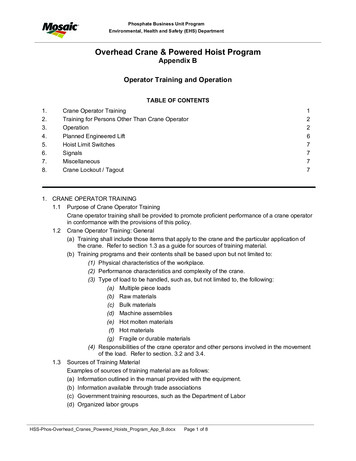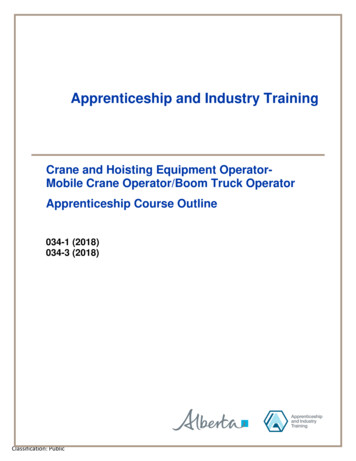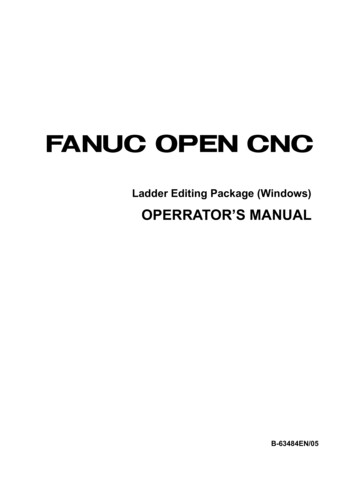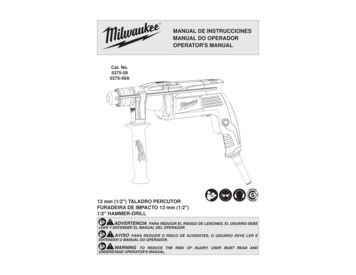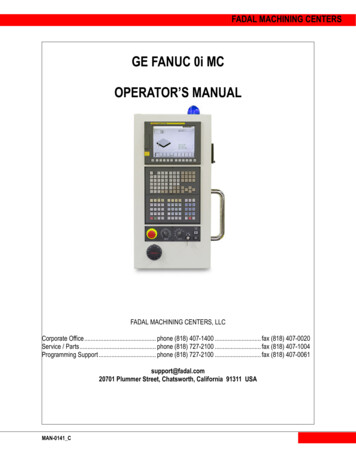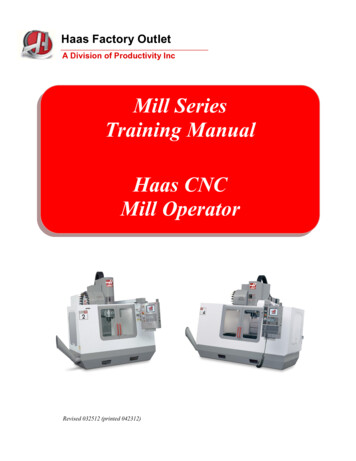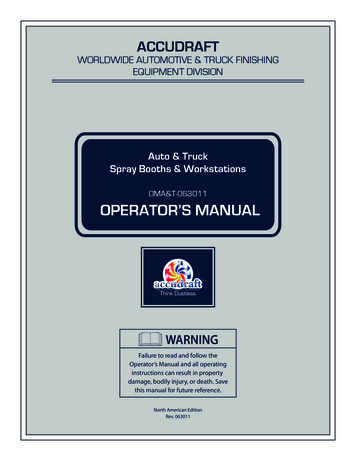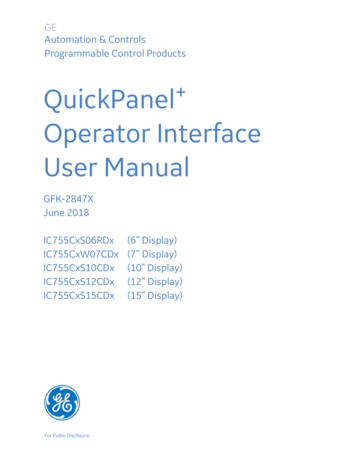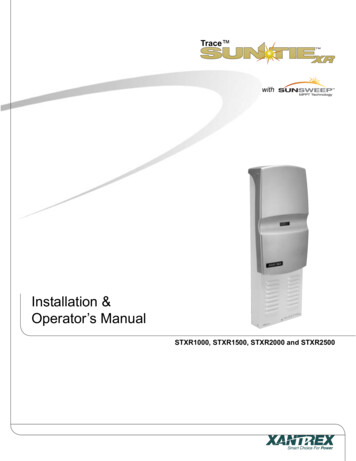
Transcription
Trace withInstallation &Operator’s ManualSTXR1000, STXR1500, STXR2000 and STXR2500
Sun Tie XR InverterSTXR1000, STXR1500, STXR2000 and STXR2500Table of ContentsSectionDescriptionPage1.0INTRODUCTION . 1Standard Features . 12.0INSTALLATION . 2Pre-Installation . 2Tools Required . 2Hardware/Materials Required . 2Location . 2AC Connections . 2DC Connections . 3STXR1500 and STXR2500 . 3STXR1000 and STXR2000 . 4Grounding . 5AC Grounding . 5DC Grounding . 5PV Arrays . 5AC Circuit Breakers . 6Wire Routing . 6Mounting . 7Wiring . 12DC Wiring . 12STXR1500 and STXR2500 DC Wiring . 12PV Array Conduit Wiring Run . 12STXR 1500 and STXR2500 DC Wiring . 14PV Array Conduit/Wire Run . 14AC Wiring . 15Installing the Optional Remote Monitor . 17Wiring to the Sun Tie . 17Lightning Protection . 183.0OPERATION . 20Start-up Procedure . 20Required Equipment . 20AC Utility Voltage Check . 20Solar Array DC Voltage Check . 21Operational Test . 224.0TROUBLESHOOTING . 265.0SPECIFICATIONS . 296.0SERVICE INFORMATION . 307.0WARRANTY . 31 2001 Xantrex Technology Inc.I
Disclaimer of LiabilitySince the use of this manual and the conditions or methods of installation, operation, use andmaintenance of the unit are beyond the control of Xantrex Technology Inc., the company does notassume responsibility and expressly disclaims liability for loss, damage, or expense arising out of orany way connected with such installation, operation, use, or maintenance.II 2001 Xantrex Technology Inc.
IMPORTANT SAFETY INSTRUCTIONSThis manual contains important safety instructions that should be followed during the installationand maintenance of this product.To reduce the risk of electrical shock, and to ensure the safe installation and operation of thisproduct, the following safety symbols have been placed throughout this manual to indicatedangerous conditions and important safety instructions.WARNING - A dangerous voltage or condition exists in this area.Use extreme caution when performing these tasks.AVERTISSEMENT - Une tension ou condition dangereuse existe dans cette zone.Faire preuve d’extrême prudence lors de la réalisation de ces tâches.CAUTION - This procedure is critical to the safe installation or operation of the unit. Follow theseinstructions closely.ATTENTION - Cette procédure est essentielle à l’installation ou l’utilisationde l’unité en toute sécurité. Suivre ces instructions de près.NOTE - This statement is important. Follow instructions closely.NOTE - Cette déclaration est importante. Suivre les instructions de près. All electrical work must be done in accordance with local and national electrical codes. Before installing or using this device, read all instructions and cautionary markings located in(or on) the manual, the STXR and the PV array. Do not expose this unit to rain, snow or liquids of any type without the rain/weather shieldhood installed (optional on some models). To reduce the chance of short-circuits when installing or working with the inverter or the PVarray, use insulated tools. Remove all jewelry such as rings, bracelets, necklaces, etc., prior to installing this system.This will greatly reduce the chance of accidental exposure to live circuits. The ST unit contains more than one live circuit (PV array and AC line). Power may be presentat more than one source even when the circuit breakers are off. This product contains no user serviceable parts. Return the unit to a Xantrex AuthorizedService Center for maintenance. Wiring to the utility should only be done after receiving prior approval from the utility companyand performed only by a qualified electrician. Completely cover the surface of all PV arrays with an opaque (dark) material BEFORE wiringthem. PV arrays produce electrical energy when exposed to light and could create ahazardous condition.SAVE THESE INSTRUCTIONS 2001 Xantrex Technology Inc.III
SOLARHARVESTED ACPOWER TO GRIDSUN TIE XRPV ARRAYAC ONOFFONOFFONOFFONOFFONOFFONOFFONSun TieMAIN UTILITYELECTRICAL PANEL975-F00-008SBDC INPUTVOLTAGEAC OUTPUTVOLTAGENOTE: This is a one line drawing intended as a system overview only. System grounding and otherelectrical details are not included.IV 2001 Xantrex Technology Inc.
1.0 INTRODUCTIONThe Sun Tie solar power conversion center is designed to convert a home or business into a“green” power generating station. The Sun Tie unit converts solar electric (PV) power into utilitygrade electricity which can be used by the home or sold to the power company. Installing a Sun Tieunit is as simple as mounting it to the wall and connecting a DC source (PV array), and the ACoutput to the utility.Standard FeaturesAll-in-one DesignAll necessary DC input and AC output connections, disconnects and circuit breakers are housedwithin the Sun Tie’s easily installed, compact enclosure. A built-in LCD panel provides easy-to-readsystem status and daily cumulative energy production information.Uses Most Types of PV TechnologyThe Sun Tie is designed to take advantage of most types of solar electric technologies. Theinverter allows up to 120 VDC open circuit PV modules to be used so both crystalline and thin filmPV modules can be used.Sun Sweep –Maximum Power Point Tracking (MMPT)Sun SweepTM is Xantrex’s proprietary Maximum Power Point Tracking technology that allows theSun Tie XR to harvest the maximum amount of energy from your solar array. No matter what PVsystem you choose, single crystalline, polycrystalline or thin film, SunSweepTM learns your array’sspecific characteristics, maximizing its output, all day, all season, year after year.High Efficiency and Long LifeThe high frequency, solid-state design of the Sun Tie inverter is extremely efficient. Above 500watts, the inversion process is 90% efficient (or greater) with a peak efficiency of 94%. The Sun Tieinverter has a design life of over twenty years.ExpandableSun Tie XR inverters may be connected in a parallel configuration for increasing net meteringcapacity. The modular expandability of the Sun Tie Series allows for system growth.UL ListedThe Sun Tie XR has complete on-board islanding protection and meets U.S. and Canadiansafety operating standards and code requirements. In North America, it is UL Listed (UL 1741-1999)and cUL listed to CSA C22.2 No. 107.1-95. NEC 690 building code requirements for PV may be metwith the optional ground fault protection (PVGFP).OptionsThese features are included on some models: PV array combiner board with six 20 amp maximum protected inputs PV array Ground Fault Protection PVGFPAccessories STRM–Sun Tie XR Remote Monitor STRS–Sun Tie XR Rain Shield 2001 Xantrex Technology Inc.1
2.0 INSTALLATIONPre-InstallationBefore installing the Sun Tie XR, read all instructions and cautionary markings located in thismanual, on the PV array and on the main service panel.NOTE: The Sun Tie weighs approximately 35 pounds (depending upon configuration and model).Always use proper lifting techniques during installation to prevent personal injury.Tools requiredPhillips screw driversslotted screw driversopen-end wrenchessocket wrench and fittingsmultimeter (true rms)frequency counter (optional)levelwire stripperstorque wrenchelectrical tapepencilutility knifeHardware/Materials requiredwood screws and washers (supplied)conduit and appropriate fittingsanchors for screws (material dependent)LocationThe Sun Tie XR unit can be mounted outdoors with the optional Rain Shield (STRS).AC ConnectionsThe inverter’s AC output breakers accept wire sizes from #6–14 AWG. Refer to the table belowfor minimum recommended wire size.Minimum Wire Size for Specified DistanceInverterModelAC AmpsOutput perlegNEC Amp(Amps x 125% )STXR10004.25.2STXR15006.37.814 AWG12 AWG10 AWGSTXR20008.310.414 AWG12 AWG10 AWGSTXR250010.41314 AWG12 AWG8 AWG0–50 FtOne Way50–100 FtOne Way100–200 FtOne Way14 AWG14 AWG12 AWG975-000-001Table 2-1Recommended Minimum AC Wire SizesNOTE: These are the minimum recommended wire sizes in conduit. Installing a large number of wiresin conduit or enclosed locations may require larger wire sizes. Consult your local/national electricalcode for more information.NOTE: The six-circuit combiner board is rated for 100 amps of maximum real current. Although the 20amp fuses will theoretically allow 120 amps to be applied, always design for a maximum of 100 ampsmaximum current. With appropriate fuse deratings, per NEC code, the maximum allowed current is 16amps for any of the six circuits.2 2001 Xantrex Technology Inc.
2.0 INSTALLATIONPre-Installation (continued)DC ConnectionsSTXR1500 and STXR2500DC connections are made on the combiner board for models STXR1500 and STXR2500. Thecombiner board accepts wire sizes from #6–14 AWG. Refer to the table below for minimumrecommended wire sizes.DC AmpsNEC Amp(Amps x 156% )Minimum Wire Size for Specified Distance0–25 FtOne Way25–50 FtOne Way50–100 FtOne Way1.01.614 AWG14 AWG14 AWG3.04.714 AWG12 AWG10 AWG5.07.812 AWG10 AWG6 AWG7.010.912 AWG8 AWG6 AWG9.014.010 AWG8 AWGNot Recommended11.017.210 AWG6 AWGNot Recommended975-000-002Table 2-2Recommended Minimum DC Wire SizesNOTE: These are the minimum recommended wire sizes. Installing a large number of wires inconduit or enclosed locations may require larger wire sizes. Consult your local/national electricalcode for more information.*NOTE: For installations requiring a two-wire run (positive and negative), the PV array wires canbypass the individual, fused combiner board terminals and connect directly to the input terminals (viaan externally mounted DC fused combiner box) by using the positive and egative bypass terminals onthe top of the combiner board. Refer to Figure 2-1 and Table 2-3 for connections and wire sizes.*Positive ( ) PV ArrayBypass TerminalPV array wiring(note polarity) *Negative (-) PV ArrayBypass Terminal–DC conduit wiring(from solar arrays)Figure 2-1Combiner Board Indicating DC PV Array Wire Connection PointsNOTE: The National Electrical Code (NEC) places restrictions on minimum DC wire bending radius. A#6 AWG wire is the largest that may be used on the STXR1500 and STXR2500 inverters whenconnecting to the individual fused circuits of the combiner board. 2001 Xantrex Technology Inc.3
2.0 INSTALLATIONPre-Installation (continued)DC ConnectionsSTXR1000 and STXR2000DC connections are made at the 100 amp DC circuit breaker and the DC negative terminal blockfor models STXR1000 and STXR2000. Refer to the table below for minimum recommended wire sizes.DC Amps(from PV array)NEC Amp(Amps x 156% )10Minimum Wire Size for Specified Distance0–25 FtOne Way25–50 Ft One Way50–100 FtOne Way15.610 AWG6 AWG4 AWG1523.48 AWG4 AWG*2 AWG2031.26 AWG4 AWG*1 AWG3046.84 AWG*2 AWGNot Recommended4062.44 AWG*1 AWGNot Recommended6093.6*2 AWGNot RecommendedNot Recommended975-000-004Table 2-3Recommended Minimum DC Wire Sizes*NOTE: The National Electrical Code (NEC) places restrictions on minimum DC wire bending radius. Ifthe enclosure’s side is used for routing the wires to the DC terminals, then the wires must be bent tomake the appropriate connections. A #3 AWG wire is the largest that may be used on the STXR1000and STXR2000 inverters if the side panel is used. Side knockouts are NOT provided on the unit.PV array Negative wiringPV array Positive wiringFigure 2-2DC PV Array Wire Connection Points(with no combiner board)4 2001 Xantrex Technology Inc.
2.0 INSTALLATIONPre-Installation (continued)GroundingAC GroundingThe Sun Tie should be connected to a grounded, permanent wiring system.DC GroundingThe negative PV conductor should be bonded to the grounding system at only one point in thesystem. The size for the conductor is usually based on the size of the largest conductor in the DCsystem. Negative/ground bonding is accomplished by factory wired PVGFP breakers (when thisoption is installed) or a factory installed grounding block (when PVGFP is not installed).PV ArraysThe Sun Tie is optimized to work with 4-each, 12 volt nominal crystalline PV modules in series (48VDC nominal), or various combinations of amorphous, thin film PV modules. Ensure the PV array usedin the system operates within the MPPT operational window.The solar array connected to the Sun Tie Series inverter should have a minimum of 50 volts DCopen-circuit in full sunlight conditions. Crystalline solar arrays configured for 48 volts DC nominal willhave a open-circuit voltage in the area of 84 volts DC in full sunlight. The maximum peak power tracking(MPPT) software controls the output of the solar modules, under loaded conditions, in the 42-85 voltsDC range (full inverter output power occurs between 52–85 VDC). Other array voltage will either notoperate the inverter, may cause damage or will not allow maximum harvest of the sun’s energy.WARNING: WHENEVER A PV ARRAY IS EXPOSED TO SUNLIGHT, A SHOCK HAZARD EXISTSAT THE OUTPUT CABLES OR EXPOSED TERMINALS. TO REDUCE THE RISK OF SHOCKDURING INSTALLATION, COVER THE ARRAY WITH AN OPAQUE (DARK) MATERIAL BEFOREMAKING ANY CONNECTIONS.STXR1000 and STXR2000 ModelsSTXR1500 and STXR2500 ModelsGround Bar Location(connect to solid earth ground)Figure 2-3Ground Bar Location 2001 Xantrex Technology Inc.5
2.0 INSTALLATIONAC Circuit BreakersThe main service panel must dedicate a 15 amp minimum, double pole breaker (120/240 volts AC)to operate the Sun Tie XR.Wire RoutingDetermine all wire routes both to and from the Sun Tie. Possible routing considerations include: AC input wiring from the main service panel to the Sun Tie DC input wiring from the PV array to the Sun Tie DC ground from the PV array to an external ground rod All wiring and installation methods should conform to applicable electrical and building codes. Pre-plan the wire and conduit runs. The DC terminal blocks accept up to a #6 AWG wire(STXR1500 and STXR2500) and #2 AWG* wire (STXR1000 and STXR2000); the AC circuitdisconnects accept cable sizes up to #6 AWG. For maximum safety, run AC and DC wires/cables in (separate) conduits.*NOTE: #2 AWG wire can only be used if the bottom knockouts are used. If punching side walls forwire routing, the largest wire for acceptable wire bend radius is #3 AWG maximum.WARNING: CHECK FOR EXISTING ELECTRICAL OR PLUMBING PRIOR TO DRILLING HOLESIN THE WALLS!6 2001 Xantrex Technology Inc.
2.0 INSTALLATIONMountingThe Sun Tie must be mounted to a flat, vertical surface such as wallboard or wood siding.Installation onto wallboard or concrete requires the use of anchors to properly hold the screws. Outdoorinstallation requires the use of the optional rain shield (STRS) to prevent water from entering the unit.WARNING: DO NOT INSTALL THE SUN TIE UNIT OUTDOORS WITHOUT THE RAIN SHIELDHOOD. WATER ENTERING THE UNIT COULD CAUSE A DANGEROUS CONDITION AND CAUSETHE UNIT TO FAIL. FAILURE DUE TO IMPROPER INSTALLATION WILL VOID THE WARRANTY.ProcedureWARNING: BEFORE DRILLING HOLES TO MOUNT THE SUN TIE, ENSURE THERE ARE NOELECTRICAL WIRES OR PLUMBING IN THIS AREA. SINCE THIS UNIT IS INSTALLED CLOSE TOTHE UTILITY ENTRANCE OR METER, THERE MAY BE A HIGH CONCENTRATION OF ELECTRICALWIRES IN THE AREA.1. Locate the area where the Sun Tie is to be installed. It should be as close to the utility service panelas possible. The bottom of the unit must be at least 36 inches from the floor or ground whenmounted.2. Using a level, place the mounting bracket up to the wall (in a horizontal position) and mark the areafor the three screws (Figure 2-4). To achieve the 36 inch height from the bottom of the Sun Tie to theground, mount the bracket 70 inches from the ground.3. If required, remove the bracket and drill the holes using a #10 (0.193 inch diameter) drill bit. Drillappropriately sized holes for anchors when installing on non-wood surfaces.4. Mount the bracket to the wall using the screws and washers provided. If mounting to other than awood wall or surface, use appropriate screws and anchors if required.5. Place the Sun Tie’s rear lip, located on the back top of the enclosure, over the bracket and ensure itis seated properly (Figure 2-5).6. Remove the lower external cover to access the internal circuit breaker panel by removing the screwon each side of the cover (Figure 2-6).7. Remove the internal breaker panel by removing the screws in the breakers. Lift the panel until thelower locking tabs are free, then gently pull the inner cover outward (Figure 2-7). Save the screws forreinstallation.8. After the unit is correctly seated on the upper bracket, locate the two screw holes in the bottom(back) area of the enclosure and mark these locations on the wall (Figures 2-5 and 2-8). Removethe Sun Tie (if required).9. Drill two pilot holes (as above, if required).10. Reinstall the Sun Tie to the bracket and secure the bottom of the unit with the wood screws andwashers provided (or appropriate screws and anchors for non-wood surfaces) and tighten (Figures 25 and 2-8).NOTE: Mounting hardware for surfaces other than wood is not supplied. 2001 Xantrex Technology Inc.7
2.0 INSTALLATIONMounting (continued)Sun Tie back viewWall Bracket, screwsand washers(supplied)Mount 70 inches from ground4068-E00-001Figure 2-4Bracket MountingSlide Sun Tie enclosure lip ontobracket9 - 41/64"4 - 13/16"19/64"Enclosuremounted on wallbracket26 - 21/32"8 - 55/64"Screwholes3.20"4068-E00-002Figure 2-5Enclosure Mounting8 2001 Xantrex Technology Inc.
2.0 INSTALLATIONMounting (continued)Upper coverRemove screws(one on each side)External breaker cover(remove during installation)Figure 2-6Outer Cover ComponentsRemove breaker screwsLift up and pull forward toremoveLocking tabsFigure 2-7Inner Breaker Cover 2001 Xantrex Technology Inc.9
2.0 INSTALLATIONMounting (continued)PV Combiner Board(included on somemodels)Internal mountingholesAC ConduitDC ConduitFigure 2-8Mounting Holes and AC DC Conduit in Customer Access Area10 2001 Xantrex Technology Inc.
2.0 INSTALLATIONMounting (continued)33832 (2X)41(2X)81387838123451210 3878758Front of Inverter834831813415810 38All dimensions are in inches258975-0003-D-001AFigure 2-9Bottom Conduit Hole Locations(Bottom View) 2001 Xantrex Technology Inc.11
2.0 INSTALLATIONWiring:DC WiringThe combiner board (included on some models) in the Sun Tie XR accepts up to six individual PVarray circuits (positive and negative wires). Each circuit on the combiner board contains a fuse to protectagainst over-current. Always replace this fuse with one of the same type and rating (GBB, 20 ampmaximum, ceramic type, 0.25" x 1.25"). The combiner board is rated for 100 amps maximum input.The combiner board PV array input connection block is located in the lower left-hand section of theSun Tie XR unit.STXR1500 and STXR2500 DC Wiring (Refer to Figures 2-10 and 2-11)PV Array Conduit/Wire Run1. Install the DC conduit from the PV arrays to the bottom of the Sun Tie, via one of the knockoutholes (Figures 2-8 and 2-9).2. Route the wires from the PV array(s) through the conduit and into the lower section of the SunTie enclosure (Figure 2-11).NOTE: If more than one solar PV array is used, label the wire pairs (positive and negative) appropriately(i.e., PV 1, PV 2, etc.).3. Connect the positive ( ) wire from the #1 array to the terminal strip labeled PV INPUT 1POSITIVE terminal. Check that the wire is in the proper location and tighten the screw.4. Connect the negative (–) wires from the PV array to the PV INPUT 1 NEGATIVE terminal.Check that the wire is in the proper location and tighten the screw.5. Repeat this procedure for each PV array circuit, connecting the #2 PV Positive wire to theterminal labeled PV INPUT 2 POSITIVE, etc.NOTE: The solar arrays do not have to connect in the order marked on the board (this is just forreference). All solar array positives on the combiner board are joined together AFTER the fuse.PVGFP (ganged)100 amp DC breakerSolar DC FusesPVGFP (ganged)1 amp DC breakerSolar DCterminal blockSolar array100 amp DC breakerL115 amp AC breaker(ganged)L215 amp AC breaker(ganged) -L2 breakerAC connectionL1 breakerAC connectionCombiner boardGrounding blockFigure 2-10STXR1500 and STXR2500 Electrical Component Location12 2001 Xantrex Technology Inc.
2.0 INSTALLATIONWiring: (continued)PV array wiring(two-line run to bypassterminals. Note polarity) –PV array wiring toterminal block(note polarity)DC conduit wiring(from solar arrays)Figure 2-11PV Array DC Connection Points (STXR1500 and STXR2500)6. Repeat this procedure for each PV array circuit, connecting the #2 PV Negative wire to theterminal labeled PV INPUT 2 NEGATIVE, etc.NOTE: For two-wire runs, use an external, fused combiner and run two wires from the externalcombiner to the bypass terminals on the combiner board. This bypasses the STXR’s combinerterminals and fuses.NOTE: The solar arrays do not have to connect in the order marked on the board (this is just forreference). All solar array negatives on the combiner board are electrically tied together.7. Torque wires according to the following table.Wire SizeTorque (in-lb)14 -10 AWG358 AWG404 - 6 AWG452 - 1/0 AWG50975-000-003Table 2-12Wire Torque Values 2001 Xantrex Technology Inc.13
2.0 INSTALLATIONWiring: (continued)STXR1000 and STXR2000 DC Wiring (Refer to Figure 2-12)PV Array Conduit/Wire Run1. Install the DC conduit from the PV arrays to the bottom of the Sun Tie, via one of the knockoutholes.2. Route the wires from the PV array through conduit and into the lower section of the Sun Tieenclosure.3. Connect the positive ( ) wire from the array to the lower terminal of the 100 amp DC CIRCUITBREAKER. Check that the wire is in the proper location and tighten the screw (Figure 2-12).4. Connect the negative (–) wire from the PV array to the lower connection of the DC NEGATIVETERMINAL. Check that the wire is in the proper location and tighten the screw (Figure 2-12).5. Torque all wires according to Table 2-4 (previous page).Use knockouts in lowersection of ST for installingconduit and routing wiresGround WirePV Array DC Negative(-) WirePV Array DC Positive( ) WireFigure 2-12PV Array DC Connection Points (STXR1000 and STXR2000)14 2001 Xantrex Technology Inc.
2.0 INSTALLATIONWiring: (continued)AC WiringAC HOT wiring is connected to the Sun Tie’s L1 and L2 breakers, the ground wire connects to theGROUND bar. All AC wiring is located in the lower section of the Sun Tie.WARNING: AC UTILITY WIRING TO THE SUN TIE UNIT IS PERFORMED DIRECTLY AT THE MAINBREAKER PANEL. THIS SHOULD BE DONE ONLY BY A QUALIFIED UTILITY INSTALLER ORELECTRICIAN WITH PRIOR UTILITY COMPANY APPROVAL.NOTE: The Sun Tie can be connected to a single bidirectional meter, or to dual meters, where onemeter indicates power used and the second meter indicates power sold (power supplied back to theutility). The installer and utility must determine the proper components to install.WARNING: BEFORE WIRING THE SUN TIE, ENSURE THE MAIN 120/240 VOLT BREAKER IN THEMAIN UTILITY BREAKER BOX IS SWITCHED OFF. SWITCH THIS BREAKER TO ON ONLY AFTERALL WIRING IS COMPLETED AS INSTRUCTED IN THE PROCEDURES.1. Run conduit from the main utility breaker panel to the lower section of the Sun Tie. Run the twoHOT wires (L1 and L2) and ground through the conduit and into the Sun Tie’s lower section.2. Install a dual 15 amp, ganged circuit breaker in the main utility breaker panel.3. Connect the L1 HOT wire (black) from the 15 amp, double-pole breaker installed in the mainbreaker panel, to the breaker labeled L1 in the Sun Tie. Refer to Figure 2-13 for STXR1500 andSTXR2500 or Figure 2-14 for STXR1000 and STXR2000 models.4. Connect the L2 HOT wire (red) from the remaining 15 amp, double-pole breaker installed inthe main breaker panel, to the breaker labeled L2 in the Sun Tie.5. Connect the ground wire (green or bare copper) from the GROUND bar in the main breakerpanel, to the GROUND bar in the lower section of the Sun Tie.6. Ensure all connections are correctly wired and properly torqued.7. Torque wires according to the following table.Wire SizeTorque (in-lb)14 -10 AWG358 AWG406 AWG45975-0003-D-003Table 2-5Wire Torque Values 2001 Xantrex Technology Inc.15
2.0 INSTALLATIONL1240 VACL2GROUND barAC conduit and wiringFigure 2-13240 VAC Connection Points (STXR1500 and STXR2500)L1240 VACL2GROUND barFigure 2-14240 VAC Connection Points (STXR1000 and STXR2000)16 2001 Xantrex Technology Inc.
2.0 INSTALLATIONInstalling the Optional Remote MonitorThe optional Remote Monitor duplicates the function of the front panel meter and can be mountedin a more accessible location such as the garage, kitchen, living room, etc. Refer to the RemoteMonitor’s installation guide for installation details.Wiring to Sun Tie1. Route the Remote Monitor’s six-conductor cable separate from the other wiring, if possible, toprevent noise and interference from being introduced into the data cable. Refer to Figures 2-15and 2-16. The connector is located in the upper right-hand section of the wiring compartment.Remote Monitor Jack(located on top of wiring accesscompartment)Optional Sun Tie XRRemote MonitorFigure 2-15Location of the Optional Remote Monitor JackCAUTION: THE SERIAL PORT CONNECTION (DB9 CONNECTOR) IS FOR AUTHORIZED FIELDSUPPORT PERSONNEL ONLY. DO NOT CONNECT A PC TO THIS PORT AS DAMAGE MAYOCCUR.Route Remote Monitor cable awayfrom AC and DC wiresRemote Monitor ConnectionCPU Board (cover removed for clarity)Figure 2-16Remote Monitor Connection and Cable2. Run the cable through one of the lower knockouts (with a strain relief installed) and plug it intothe Remote Monitor port.3. Recheck all wiring and reinstall the panels and the Rain Shield (if used). 2001 Xantrex Technology Inc.17
2.0 INSTALLATIONLightning ProtectionTo protect the equipment from lightning damage, a single point grounding system should beused. In this system, all ground lines terminate at the same point. This point normally is the mainutility ground installed by the utility company to provide a ground for the house wiring. This groundusually consists of a copper rod driven 6 to 8 feet into the earth. Ground roof mounted solar arrayframes directly to the external utility ground rod (Figure 2-17).If the solar array is located a considerable distance from the Sun Tie, then an additionalground rod must be installed close to the solar array for the most reliable lightning protection(Figure 2-18). The grounded frame of the solar array provides a direct route to dissipate lightningstrikes via the close ground rod. Tie this ground rod to the main utility ground rod via a heavygauge (#8–6 AWG) bare copper wire which can be buried underground. Tieing these groundstogether constitutes a single point ground and provides the best protection from lightning damage.Refer also to the NEC for specific grounding requirements.SolarArrayMain UtilityBreaker PanelST UnitAC WiringUtilityMeterGroundBarACWiring toUtilityACWiringGroundBarDC WiringBonded Neutral WireUtility GroundWireArray Ground WireUtilityGroundRod957-F00-007Figure 2-17Typical Roof Mount Installation Grounding 100 feet (30 m)Main UtilityBreaker PanelST UnitSolarArrayAC WiringGroundBarACWiringGroundBarDC WiringGroundFrame toPoleUtilityMeterACWiring toUtilityBonded Neutral WireArray Ground WireUtility GroundWireBuried Copper WireArray Ground RodUtility Ground Rod975-F00-006Figure 2-18Long Distance Grounding18 2001 Xantrex Technology Inc.
2.0 INSTALLATIONPVARRAYSST UNITPV COMBINER BOARDSOV20 APV GROUND FAULTBREAKERS (OPTION)LIGHTNINGARRESTOR(OPTION)A100 A15 AL1L1 –L2GG100 A20 A–20 A 15 AL2––INVE
CAUTION - This procedure is critical to the safe installation or operation of the unit. Follow these instructions closely. ATTENTION - Cette procØdure est essentielle à l installation ou l utilisation de l unitØ en toute sØcuritØ. Suivre ces instructions de prŁs. NOTE - This statement is important. Follow instructions closely.
